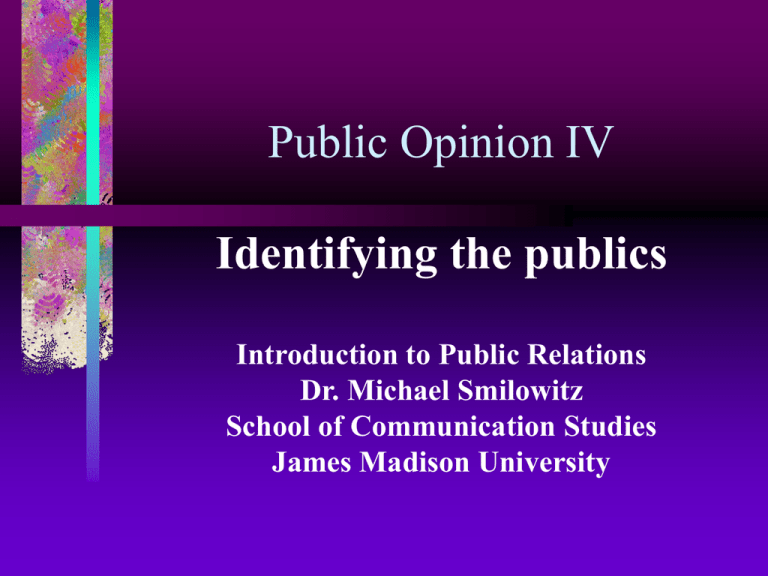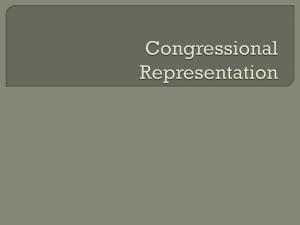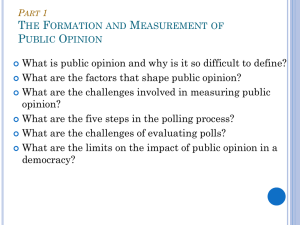Public Opinion IV - James Madison University
advertisement

Public Opinion IV Identifying the publics Introduction to Public Relations Dr. Michael Smilowitz School of Communication Studies James Madison University What to expect: 1. Develop a complicated understanding of publics. 2. Reject the concept of a “general public.” 3. Describe Grunig’s situational theory of publics. • Two schemes for classifying publics. • Discuss the relationships among “selfinterest” and opinions. 2 3 Identifying the publics Cutlip, Center and Broom discard the notion of a “general public.” “The mosaic of the many different ethnic, racial, religious, geographic, political, occupational, and special-interest groupings…make the concept of little, if any, value in public relations.” Identifying the publics Other reasons why “general public opinion” is a meaningless concept. – Few, if any, issues create unanimous opinions. • Multiple opinions surround most issues. • Multiple opinions occur in groups regardless of the scale (national, state, regional, even local). – People may be involved in some issues, and apathetic towards others. – Special issue groups attempt to claim to be the voice of the majority. 4 Grunig’s Situational Theory of Publics James Grunig, in a series of articles and books, developed approaches for defining publics from a communication point of view. Grunig’s theory minimizes the value of, static, cross-situational characteristics for defining publics. Cross situational factors include such things as demographics and psychographics. 5 Grunig’s Situational Theory of Publics Grunig’s approach emphasizes, instead, the situational characteristics of publics. His definition: Publics are constituted by individuals who share mutual interests in particular situations that tie these individuals to certain issues. 6 Grunig’s Situational Theory of Publics Grunig offers two different (but related) categories for classifying publics. – One category scheme is based on issue involvement. – One category scheme is based on level of problem awareness. 7 Grunig’s Situational Theory of Publics Grunig identifies four types of publics based on issue involvement: – All issue publics Active on all issues. – Apathetic Publics Inactive on all issues. – Single issue publics Active on one or a limited number of related issues. – Hot issue publics Media generated publics on topics of widespread social conversation. 8 Grunig’s Situational Theory of Publics Grunig also identifies four types of publics based on problem awareness. – – – – Non-publics Latent publics Aware publics Active publics 9 Grunig’s Situational Theory of Publics areof groups of Grunig also identifiesNon-publics four types publics people who may share based on problem awareness. similar geographic or – – – – Non-publics Latent publics Aware publics Active publics demographic characteristics, but are not mutually involved with the client. They are not affected by the client, nor do they affect the client. 10 Grunig’s Situational Theory of Publics Grunig also identifiesLatent fourpublics types are of not publics aware of the impact the based on problem awareness. client has on them, or – – – – Non-publics Latent publics Aware publics Active publics their impact on the client, with regards to some issue or problem situation. A latent public might exist due to: • apathy • lack of information. 11 Grunig’s Situational Theory of Publics Aware Grunig also identifies fourpublics typesareofthose publics people who recognize based on problem mutual awareness. involvement with – – – – Non-publics Latent publics Aware publics Active publics other people on some issue or problem relevant to the client, and seek information on the issue. But an “aware public” does not do more than possibly share information with one another. 12 Grunig’s Situational Theory of Publics Grunig also identifiesActive fourpublics typesorganize of publics themselves to share based on problem awareness. information, plan, and – – – – Non-publics Latent publics Aware publics Active publics take steps to do something about the issue or situation. 13 Grunig’s Situational Theory of Publics Three situational factors identify active publics: 1. Problem recognition 2. Constraint recognition 3. Level of involvement 14 Grunig’s Situational Theory of Publics 1. Problem recognition The extent to which people are aware of the existence of a problem in their own spheres of activity. 15 Grunig’s Situational Theory of Publics 2. Constraint recognition People see themselves as capable of remedying the problem, or see themselves “stuck” in circumstances beyond their control. • If people think they can have an effect on the problem, they are likely to seek more information. 16 Grunig’s Situational Theory of Publics 3. Level of involvement Refers to the extent that people see themselves as affected by a situation. • The more that people see themselves affected by a situation, the more likely they will communicate about it. 17 18 Self-interest and opinion • Opinions about issues significantly affect behavior to the extent that self-interest is involved. • Opinion does not remain aroused unless people continue to feel their self-interests are involved. • Once self-interest is involved, opinion is not easily changed.








